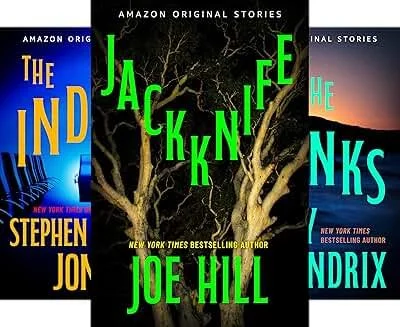MY RATING: Recommended*
REVIEW: Stephen Graham Jones’ The Buffalo Hunter Hunter is a moody, often fever-dream-like, occasionally brutal vampire novel set against some of the bloodiest moments of Montana history. It is part vampire memoir, part family drama, and part mystery, takes a number of surreal turns, and plays with modern expectations of vampire lore – all of which adds up to a thrilling, engrossing, and thought-provoking novel.
The set-up: Etsy Beaucairne is informed of the discovery of a journal written by her great-grandfather Arthur, a Lutheran priest in Miles City Montana in the early 1900s. The journal is not only a link to lost family history, it may also provide Etsy with a way to move her stalled life forward. What she discovers in the journal is the confession of a Blackfeet Indian named Good Stab, who professes to be a vampire. Good Stab also appears to be behind a string of deaths and disappearances in both San Francisco and Miles City. The book alternates between Etsy’s 2020’s present, Arthur’s journal entries in the 1910s as he's taking the confession, and Good Stab’s recounting of his existence through the 1800s.
Good Stab’s memoir is the most surreal, fever-dream like part of the book (at least until near the end), especially in his early days as a vampire coming to understand what he has become, what he can do, and the limitations he is faced with. It is here that Jones plays most with genre expectations of a vampire’s existence and abilities, as the blood Good Stab consumes affects not only his physical appearance but his cognitive abilities. (If there are other vampire novels that touch on this the way Jones does, I haven’t come across them yet.) Good Stab is not the sparkly teen or brooding aristocrat of so much modern vampire fiction, but he has more character depth than the vampires of fiction from the Gothic era. There is also no romance in his story – but there are moments of unexpected beauty in his connection to the natural world and to his people.
There is also a lot of mystery connected to the telling of Good Stab’s story. Why has he chosen Arthur to tell his story to, and why now? What is Good Stab’s connection – if any – to the spate of dead bodies showing up on the outskirts of Miles City? Arthur’s personal history has some mystery as well, alluded to and hinted at in his self-observations throughout the journal: how did he come to be a pastor in this frontier town? How did he get the injury that affects his ability to walk? I would describe this mystery element of the book as “fair play:” in that the answers to all of these questions are embedded, some subtly, in the narrative and after the reveals the reader can go back and string those hints together.
The mystery also ties into the family drama, as Etsy tries to understand her great-grandfather’s journal in the context of what her family knew and didn’t know about his life and disappearance. Etsy and Arthur both encounter crossroads at which revealed knowledge forces a decision that will change the course of their lives.
Throughout the book Jones deals straightforwardly with how colonialism and American westward expansion affected the native population, and how steeped in blood the history of Montana (and by extension, all of the American West) is – a history many of us did not learn about in school, a history we should know about and learn from.
The Buffalo Hunter Hunter is not an easy read, but it is an engrossing and thought-provoking one. I recommend it.
*I have moved away from a star-based rating system here on the blog (I can’t avoid using stars on Goodreads, NetGalley, and the various bookseller sites). Instead I am switching to ranking books as “highly recommended,” “recommended,” “satisfactory” and “not right for me.” I may add other levels as I refine this concept. I’ll be including this note in all of my reviews for the next several weeks.
I received an electronic advance reading copy of this book for free from the publisher via NetGalley in exchange for an honest review. This does not affect my opinion of the book or the content of my review. I finished the book well before the release date but fell behind posting reviews. The Buffalo Hunter Hunter is available now wherever books are sold.


